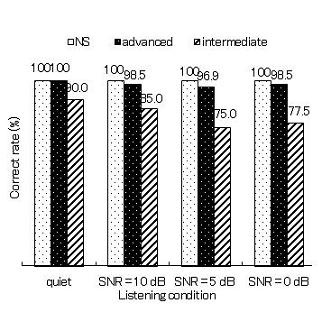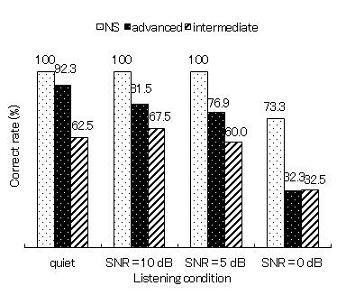Listening to speech in noise is difficult for everyone, especially for non-native listeners (Lecumberri & Cooke, 2006). The listener’s proficiency in the target language plays an important role in how well one is able to identify certain sounds in foreign languages (Masuda & Arai, 2010). However, it does not mean that highly fluent (or ‘bilinguals’) learners are able to listen like the native listeners especially when there is background noise (Mayo et al., 1997). The two graphs show that the identification of /r/ by advanced level learners is as high as that of the native listeners even in the most adverse condition. On the other hand, the identification of /l/ by advanced level learners is similar to that of the intermediate level learners in the most adverse condition (Masuda & Arai, 2012). Therefore, it is important to investigate which sounds are difficult to identify in noise for learners with various proficiency.
This demonstration shows that listening to English /r/ and /l/ sounds in background noise is difficult for Japanese listeners. The two graphs below show the results of the perception of English /r/ and /l/ by Japanese and English listeners (The x-axis shows the listening conditions, ranging from quiet to most adverse condition: SNR=0dB). The background noise used for this demonstration is called “babble noise”, which is a kind of noise where people are talking but cannot hear what they are talking about. This noise resembles places such as noisy cafeterias and parties. Even if you are able to identify /r/ and /l/ in quiet listening condition, it does not mean you can also identify them in background noise.

| quiet | SNR=10dB | SNR=5dB | SNR=0dB | |
|---|---|---|---|---|
| /r/ |

| quiet | SNR=10dB | SNR=5dB | SNR=0dB | |
|---|---|---|---|---|
| /l/ |
- Lecumberri, M.L. and Cooke, M., Effect of masker type on native and non-native consonant perception in noise, Journal of the Acoustical Society of America, 119 (4), 2445-2454, 2006.
- Masuda, H. and Arai, T., Processing of consonant clusters by Japanese native speakers: Influence of English learning backgrounds, Acoustical Science and Technology, 31(5), pp. 320-327, 2010.
- Masuda, H. and Arai, T., Perception of /r/ and /l/ in quiet and multi-speaker babble noise by Japanese and English native listeners, Proceedings of the Spring Meeting of Acoustical Society of Japan 2012, pp.477-480, 2012.
- Mayo, L.H., Florentine, M. and Buus, S., Factors affecting the recognition of words in a second language, Bilingualism: Language and Cognition, 3 (1), 55-67, 2000.